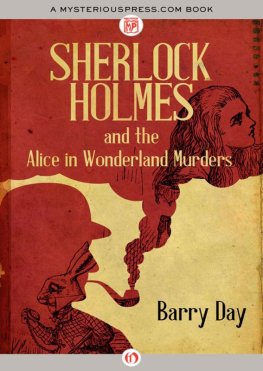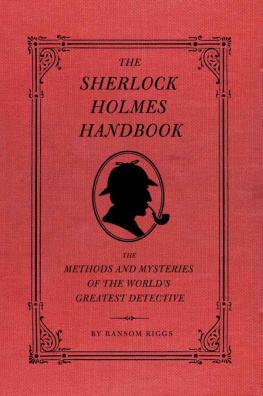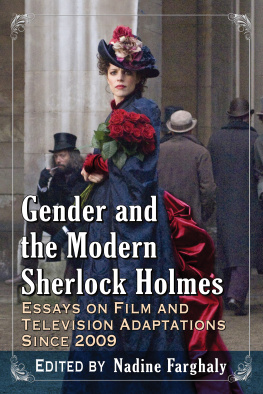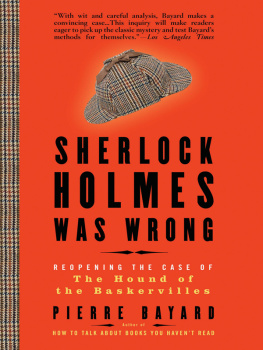Title Page
ENGLANDS SECRET WEAPON
The Wartime Films of Sherlock Holmes
Amanda J. Field
Publisher Information
First published in 2009 by Middlesex University Press
Fenella Building
The Burroughs
Hendon
London NW4 4BT
www.mupress.co.uk
Digital Edition converted and distributed in 2012 by
Andrews UK Limited
www.andrewsuk.com
Copyright 2009, 2012 Amanda J. Field
All rights reserved. No part of this publication may be reproduced, stored in any retrieval system or transmitted in any form or by any means, electronic,mechanical,photocopying, recording or otherwise,without the prior written permission of the copyright holder for which application should be addressed in the first instance to the publishers.No liability shall be attached to the author, the copyright holder or the publishers for loss or damage of any nature suffered as a result of reliance on the reproduction of any of the contents of this publication or any errors or omissions in its contents.
List of Illustrations
Fig. 1 : Frederic Dorr Steele illustration for Colliers magazine (1903)
Fig. 2 : William Gillette as Holmes
Fig. 3 : Eille Norwood as Holmes (1920s)
Fig. 4 : Clive Brook as Holmes (1929)
Fig. 5 : Arthur Wontner as Holmes (1930s)
Fig. 6 : The Hound of the Baskervilles poster (1939)
Fig. 7 : The Adventures of Sherlock Holmes poster (1939)
Fig. 8 : Sherlock Holmes and the Voice of Terror poster (1942)
Fig. 9 : Sherlock Holmes and the Secret Weapon poster (1942)
Fig. 10 : Sherlock Holmes in Washington poster (1943)
Fig. 11 : The Scarlet Claw poster (1944)
Fig. 12 : The House of Fear poster (1945)
Fig. 13 : Spider Woman poster (1944)
Fig. 14 : The Pearl of Death poster (1944)
Fig. 15 : The Woman in Green poster (1946)
Fig. 16 : Terror by Night poster (1946)
Fig. 17 : Dressed to Kill poster (1946)
Fig. 18 : A distinctive profile: Rathbone in The Hound of the Baskervilles
Fig. 19 : Graveyard in The Hound of the Baskervilles
Fig. 20 : Staircase to 221B Baker Street in The Adventures of Sherlock Holmes
Fig. 21 : Filming The Hound of the Baskervilles on the cyclorama sound stage
Fig. 22 : Lamplighter in The Adventures of Sherlock Holmes
Fig. 23 : Victorian city-wear in The Adventures of Sherlock Holmes
Fig. 24 : Dr Mortimer meeting Sir Henry off the ship in The Hound of the Baskervilles
Fig. 25 : Wasp waist costume in The Hound of the Baskervilles
Fig. 26 : Ann Brandons arrow hat in The Adventures of Sherlock Holmes
Fig. 27 : Mediaeval dress in The Hound of the Baskervilles
Fig. 28 : Needle cartoon from The Hound of the Baskervilles pressbook
Fig. 29 : Denis Conan Doyle letter from Sherlock Holmes and the Voice of Terror pressbook
Fig. 30 : East Wind setting in Sherlock Holmes and the Voice of Terror
Fig. 31 : Newsreel-style opening to Sherlock Holmes and the Voice of Terror
Fig. 32 : Swiss bierkeller in Sherlock Holmes and the Secret Weapon
Fig. 33 : Interior of 221B Baker St in Sherlock Holmes and the Voice of Terror
Fig. 34 : Typical modern art deco room of the 1940s
Fig. 35 : Men from the ministry in Sherlock Holmes and the Voice of Terror
Fig. 36 : Soundwave monitor in Sherlock Holmes and the Voice of Terror
Fig. 37 : Watson in hallway in Sherlock Holmes Faces Death
Fig. 38 : VR bullet-holes in Sherlock Holmes Faces Death
Fig. 39 : The Creeper in The Pearl of Death
Fig. 40 : Spanish lobby card for The House of Fear
Fig. 41 : Firelit caf in The Scarlet Claw
Fig. 42 : Inside the church, from The Scarlet Claw
Fig. 43 : Shipboard scene in The Pearl of Death
Fig. 44 : Nightclub in The Woman in Green
Fig. 45 : Sari costume in Spider Woman
Fig. 46 : Clawlike dress in Spider Woman
Fig. 47 : Phallic hat in Spider Woman
Fig. 48 : Interior of Adrea Speddings apartment in Spider Woman
Fig. 49 : Actress Evelyn Ankers in pressbook for The Pearl of Death
Fig. 50 : Vivian Vedder in Terror by Night
Fig. 51 : Booths Gin advertisement with Basil Rathbone
Illustration sources and copyright acknowledgements
The Arthur Conan Doyle Collection, Richard Lancelyn Green Bequest, generously made the following photographs from their collection available: Figs 1-2, 5-13, 15, 21, 23, 25, 27-28, 35-36, 46-47 and 50. A number of illustrations are screenshots (Figs 18-20, 22, 24, 26, 30-33, 37-39 and 41-43) taken by the author; all others not listed above are from the authors own collection.
All images from The Hound of the Baskervilles and The Adventures of Sherlock Holmes are the copyright of Twentieth Century-Fox. All images from the other 12 films in the Holmes series are the copyright of Universal. The art deco room (Fig 34) is the copyright of the Geffrye Museum and the Booths Gin advertisement (Fig. 51) is the copyright of Booths Gin.
Cover image: publicity photo of Basil Rathbone and Nigel Bruce as Sherlock Holmes and DrWatson in the 19421946 series of films from Universal. British Film Institute: Stills, Posters and Designs.
Acknowledgements
I am grateful to Portsmouth City Museum for the opportunity to work on the Arthur Conan Doyle Collection, Richard Lancelyn Green Bequest, from the initial receipt of the boxes through to final cataloguing, enabling me to have early access to many documents; and in particular to Sarah Speller for permission to use some of the stills in the Collection. Also to Ned Comstock at the University of Southern California for making the Universal production files for the films available; Lauren Buisson at UCLA for access to the Twentieth Century-Fox legal files; the Margaret Herrick Library for Production Code Administration files; the British Film Institute library for access to trade and consumer magazines; and Catherine Cooke at Westminster Libraries for access to books in the Sherlock Holmes Collection. Lastly, without the encouragement and enthusiasm of Dr Michael Williams of the University of Southampton, and the willingness of my husband John Bull to watch the Holmes series with me over and over again, this book would certainly not have come to fruition.
Introduction
Though the world explode, these two survive And it is always eighteen ninety five
Vincent Starrett
It is midnight. Clouds scud across the face of the Houses of Parliament as Big Ben begins its familiar chime. The chime continues while the scene fades out to reveal a Baker Street road-sign lit by a gas flare: as the camera pans along a brick wall, the flare makes dimly visible 221B elegantly sign-written on the entrance door below. The scene cuts to a close-up of an article in The Times , about the arrival from Canada of Sir Henry Baskerville, heir to the Baskerville estate. In a midshot, we see Dr Watson seated comfortably at a library-table, scissors in hand, preparing to clip the item out of the paper. He complains to a pacing, dressing-gowned Holmes that he cant understand why Holmes wants all the clippings about this Baskerville fellow. My conjecture, replies Holmes, as the camera cuts to his face in profile, is that hell be murdered. Murdered? echoes a baffled Watson. It will be very interesting to see if my deductions are accurate, replies Holmes, sucking contemplatively on his calabash pipe. After some showy deductions about a walking stick, left behind earlier that evening (Watson confidently getting it all wrong, and Holmes affectionately putting him right), the door opens and Mrs Hudson ushers in the sticks owner, Dr Mortimer. Mr Holmes, the man says in an urgent tone, youre the one man in all England who can help me.
This scene, from The Hound of the Baskervilles , a Twentieth Century-Fox film released in 1939, contains the first glimpse of Basil Rathbone as Holmes and Nigel Bruce as Watson in what would become a long-running series spanning the years of war in Europe. It introduced viewers to a new interpretation of Sherlock Holmes, a character with whom they probably already had considerable familiarity gained through the Doyle stories, previous film and stage incarnations, radio series, comic strips, parodies, or a combination of all these. Holmes had been a transmedia figure for more than 40 years when this film was released: in terms of cinema alone, this was his 100th appearance and Basil Rathbone was the 23 rd actor to play the character. This meant that audiences would have certain preconceptions of how Holmes should look and behave, and would judge this new interpretation as to whether it represented the real Holmes. Which particular point of origin they would use as a yardstick is, however, debatable: Christopher Frayling has pointed out just how far from the literary original these perceived constructs can stray:
Next page







